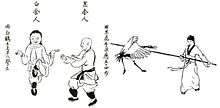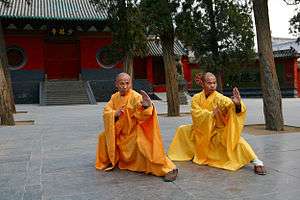Fujian White Crane
 | |
| Also known as | Pe̍h-ho̍h-kûn |
|---|---|
| Focus | Striking |
| Country of origin | China |
| Creator | Fāng Qīnián (tradition) |
| Famous practitioners |
Lǐ Wénmào Chen Zuozhen Huang Laoyang |
| Parenthood | Ming-era Nanquan |
| Descendant arts | Southern Praying Mantis, Wuzuquan, Wing Chun, Karate (Goju Ryu, Chitō-ryū, Uechi-ryu) |
| Fujian White Crane | |||||||||||||
| Traditional Chinese | 白鶴拳 | ||||||||||||
|---|---|---|---|---|---|---|---|---|---|---|---|---|---|
| Simplified Chinese | 白鹤拳 | ||||||||||||
| Literal meaning | white crane fist | ||||||||||||
| |||||||||||||
| Alternative Chinese name | |||||||||||||
| Chinese | 永春白鶴拳 | ||||||||||||
| Literal meaning | eternal spring white crane fist | ||||||||||||
| |||||||||||||
| Fujian White Crane | |
|---|---|
| Mandarin: | Bái Hè Quán |
| Amoy Min Nan: | Pe̍h-ho̍h-kûn |
| Literally | "white crane fist" |
- This article is about the Fujian style, White Crane. For the Tibetan style of White Crane, see Lama (martial)
White Crane Style (in Chinese: 白鶴拳) is a Southern Chinese martial art that originated in Fujian (福建) province. According to oral tradition, the style was developed by Fang Qīniáng (方七娘; Amoy Min Nan: Hng Chhit-niâ), a female martial artist. It is associated with traditional fighting techniques, including long range, but is most similar to close-quarter or hand-to-hand combat.[1] It is most recognizable by the way the fighter imitates a bird's pecking or flapping of wings. While some white crane styles make use of traditional weapons, others have discontinued the use of weaponry.[2]
Fujian White Crane is a type of Shaolin Boxing that imitates characteristics of the Taiwanese Crane. An entire system of fighting was developed from observing the crane's movements, methods of attack and spirit. It is one of the six well-known schools of Shaolin Boxing. The others are based on Tiger, Monkey, Leopard, Snake and Dragon. Additional, lesser-known schools include Dog, Deer and Bear.
| Part of a series on |
| Chinese martial arts (Wushu) |
|---|
 |
|
Styles of Chinese martial arts
|
| Wushu in the world |
|
Historical locations Chen Village (陳家溝) |
| Wushu athletes/practitioners |
|
Legendary figures Bodhidharma (菩提達摩) |
|
Historical individuals Yue Fei (岳飛; 1103—1142) |
|
Modern celebrities Bruce Lee (李小龍 1940—1973) |
| Wushu influence |
|
Related |
The legend of the white crane
Qīniáng and her father lived in Fujian province, where many cranes live. Qīniáng's father knew the Southern Chinese Martial Arts and taught them to his daughter. One day, while Qīniáng was doing her chores, a crane landed nearby. Qīniáng tried to scare the bird off using a stick and the skills she had learned from her father, but whatever she did, the crane would counter. Qīniáng tried to hit the crane on the head, but the bird moved its head out of the way and blocked the stick with its wings. Qīniáng tried to hit the crane's wings, but the crane stepped to the side and blocked the stick with its claws. Qīniáng tried to poke the crane's body, but the crane dodged backwards and struck the stick with its beak. From then on, Qīniáng carefully studied the crane's movements. She combined these movements with techniques learned from her father, ultimately creating the White Crane Style of Fujian province.
There are many versions of this legend. In some the crane does not block a stick, but evades and counters it. The point of the style is to emphasize evasion and attack an opponent's vulnerabilities instead of using physical strength. Since it was created by a woman, White Crane fighting elements are especially popular in women's self-defense training because the movements do not require great strength. They more closely imitate the delicate pecking motion associated with this fighting style.[3] Popular karate bunkai (breakdown) of white crane katas like hakutsuru stress vital point striking or kyusho.
Branches
Over time, White Crane branched off into 5 styles:
| Chinese | Pinyin | Minnan | ||
|---|---|---|---|---|
| Sleeping Crane Fist | 宿鶴拳 | sù hè quán | siok4 hoh8 kun5 | also known as Jumping, or Ancestral Crane |
| Crying Crane Fist | 鳴鶴拳 | míng hè quán | beng5 hoh8 kun5 | also known as Calling, Whooping, or Shouting Crane |
| Eating Crane Fist | 食鹤拳 | shí hè quán | chiah8 hoh8 kun5 | also known as Morning Crane |
| Flying Crane Fist | 飛鶴拳 | fēi hè quán | hui1 hoh8 kun5 | aka fei hok kuen |
| Shaking Crane Fist | 縱鶴拳 | zòng hè quán | hui1 hoh8 kun5 | aka jun hok kuen |
History
According to the traditions of the Lee family branch of Flying Crane, Fāng Qīniáng was born in the mid-18th century.
According to this tradition, the Ong Gong Shr Wushuguan was established in the town of Yongchun (永春; Minnan: eng2 chhun1), prefecture of Quanzhou, Fujian province, when its founders were taught by Fang Qiniang during the reign of the Jiajing Emperor (r. 1521–66) of the Ming dynasty.
Pingyang White Crane was created by Fāng Qī Niáng during Shunzhi period during the Qing dynasty. During Jiaqing period, this kongfu spread to Pingyang city.[4]
Yongchun White Crane was created by Fāng Qī Niáng during KangXi period during the Qing dynasty. Yongchun combined the movements of White Crane with Shaolin kongfu. The film Yongchun White Crane describes the history and development of this Kongfu.[5]
Li Wenmao (李文茂), an opera performer and leader of the 1854–1856 Red Turban Rebellion in Foshan, is said to have practiced the Yǒngchūn style of White Crane.
The Xu-Xi Dao style of White Crane as taught by Chen Zhuozhen was derived from Zhong-Ho 'Springing Crane' and was developed in Taiwan by Huang Laoyang in the 1950s.
Feeding Crane in Taiwan
The lineage of Feeding Crane in Taiwan is:
- 方七娘 - Fāng Qī Niáng
- 曾四叔 - Zēng Sì Chū
- 鄭禮叔 - Zhèng Lǐ Shū
- 蔡忠叔 - Cài Zhōng Shū
- 蔡公頸 - Cài Gōng Jǐng
- 林德順 - Lín Dé Shùn
- 劉故 - Liú Gù
- 劉銀山 - Liú Yín Shān
- 劉長益 - Liú Zhǎng Yì (Liu Chang I)
Influence
Fujian White Crane is one of the constituent styles of Five Ancestors.[6]
Five Ancestors as well as various styles of Karate, notably Goju-ryu, Chitō-ryū and Uechi-ryu use the routine "San Chian" from Fujian White Crane. San Chian is best known by the Japanese pronunciation of its name, Sanchin.[7]
See also
References
- ↑ Yang, Jwing-Ming (1 October 2016). The Essence of Shaolin White Crane: Martial Power and Qigong. YMAA Publication Center, Incorporated. ISBN 978-1-59439-160-6.
- ↑ "Power of the Animals". Inside Kung Fu. Retrieved 2009-12-29.
- ↑ "Fujian White Crane". Inner Martial Arts. Retrieved 8 March 2016.
- ↑ "白鹤拳_百度百科". baike.baidu.com. Retrieved 2016-03-09.
- ↑ "永春白鹤拳_百度百科". baike.baidu.com. Retrieved 2016-03-09.
- ↑ "Five Animals Shaolin Martial Arts : Crane Fighting Style in Shaolin Martial Arts". eHow. Retrieved 2009-12-28.
- ↑ "KUNG FU PANDA: Big Bear Cat was "PO-fect"". Kung Fu Magazine. Retrieved 2009-12-27.
Sources
- Bubishi George Alexander ISBN 0-9631775-1-6 and Secrets of the Bubishi DVD ASIN : B00015400K
- McCarthy, Patrick (1995). Bible of Karate, The; Bubishi. Tuttle Publishing. ISBN 978-0-8048-2015-8.
External links
- Su Yin Han White Crane
- White Crane Martial Arts
- Southern Crane Kungfu & Tai Chi U.K.
- FuJian White Crane Kung Fu Club
- White Crane Kung Fu
- White Crane Fighting Arts
- All Masters Martial Arts Centre
- Feeding Crane - Taiwan - Liu Chang I
- Traditional White Crane Kung Fu (USA) - Dr. Lee's Academy